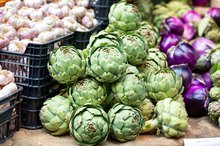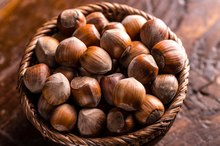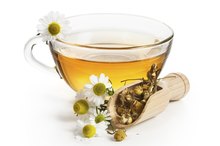Herbs That Cause Allergies
People who suffer from allergies, especially as a result of hay fever or other pollen reactions, can experience additional complications of their allergies if they try certain herbal remedies, particularly remedies from sources in the same plant family as their allergens. Having a solid knowledge of which plants trigger allergies and which herbs share the same pollens is key to health safety in people with allergies.
If you are experiencing serious medical symptoms, seek emergency treatment immediately.
Chamomile
Chamomile is best known as a soothing herb that relieves stress, cold symptoms and skin reactions such as itching or hives. Chamomile can be found in topical lotions, in numerous marketed products and in tea formulations. However, this popular herb is not necessarily safe for people with allergies to ragweed pollens, because chamomile and ragweed are in the same plant family, Compositae.
Echinacea
What Foods Should You Stay Away From If You Have Pollen Allergies?
Learn More
Similar to the chamomile cross reaction, echinacea can induce allergy symptoms in people with an existing ragweed allergy because of the shared plant family 3. Echinacea is often used to relieve symptoms similar to allergies, such as sore throat from colds and flu. People with an allergy to ragweed pollen who ingest echinacea may experience worsened allergy symptoms as well as stomach upset and rash 3. Severe reactions, including shock, are possible.
Dandelion
Although a distinct plant species from chamomile, echinacea and daisy, dandelion is also a member of the larger Compositae plant family. However, its allergy risks are not limited to the ragweed cross sensitivity. People with an allergy to latex may experience allergic reactions to dandelions, whether through the inhaled pollen, actual contact, or ingestion of an herbal liquid or capsule formulation. Latex may be produced from one species of the dandelion plant; latex contact may lead to anaphylaxis, a life-threatening shock reaction, in particularly sensitive individuals.
- Although a distinct plant species from chamomile, echinacea and daisy, dandelion is also a member of the larger Compositae plant family.
- Latex may be produced from one species of the dandelion plant; latex contact may lead to anaphylaxis, a life-threatening shock reaction, in particularly sensitive individuals.
Food and Plant Allergies
Dandelion Allergy
Learn More
Sometimes, herbal sources lead to reactions from specific foods in people with severe allergies. The reactions may be full-body allergies or an oral allergy syndrome, or OAS, in which the only symptoms are usually itching and redness around the mouth after eating certain foods. Allergies to herbal plant groups like birch, for example, can cause OAS with tree fruits like apples and cherries and can cause allergic cross reactions with hazelnuts from the related hazel tree. Similarly, people with severe ragweed allergies may be unable to eat cantaloupe or sunflower seeds because of the shared plant family.
- Sometimes, herbal sources lead to reactions from specific foods in people with severe allergies.
- Allergies to herbal plant groups like birch, for example, can cause OAS with tree fruits like apples and cherries and can cause allergic cross reactions with hazelnuts from the related hazel tree.
Related Articles
References
- Herbs 2000: Common Ragweed
- University of Maryland Medical Center: German Chamomile
- Asthma and Allergy Foundation of America: Ragweed Allergy
- Health on the Net Glossary: Allergy: Compositae
- American College of Allergy, Asthma & Immunology. Ragweed Allergy. Updated April 23, 2018.
- Asthma and Allergy Foundation of America. Ragweed Pollen Allergy. Updated August 2019.
- Gautier C, Charpin D. Environmental triggers and avoidance in the management of asthma. J Asthma Allergy. 2017;10:47-56. doi:10.2147%2FJAA.S121276
- Yamauchi K, Ogasawara M. The Role of Histamine in the Pathophysiology of Asthma and the Clinical Efficacy of Antihistamines in Asthma Therapy. Int J Mol Sci. 2019;20(7) doi:10.3390/ijms20071733
- Katelaris CH. Food allergy and oral allergy or pollen-food syndrome. Curr Opin Allergy Clin Immunol. 2010;10(3):246-51. doi:10.1097/aci.0b013e32833973fb
- Mastrorilli C, Cardinale F, Giannetti A, Caffarelli C. Pollen-Food Allergy Syndrome: A not so Rare Disease in Childhood. Medicina (Kaunas). 2019;55(10). doi:10.3390/medicina55100641
- American College of Allergy, Asthma, & Immunology. Skin test. Updated April 16, 2018.
- Seidman MD, Gurgel RK, Lin SY, et al. Clinical practice guideline: allergic rhinitis. Otolaryngol Head Neck Surg. 2015;152(1 Suppl):S1-43. doi:10.1177/0194599814561600
- Asthma and Allergy Foundation of America. Ragweed Allergy
- American Academy of Allergy Asthma & Immunology. Topic of the Month: August 2006: Ragweed, allergies and hay fever
Writer Bio
Nicole Van Hoey is a pharmacist and medical writer/editor in Washington, D.C. She has worked extensively on National Institutes of Health and trade pharmacy publications and is a contributing textbook writer on topics in infectious disease, nutrition and more. Van Hoey currently enjoys applying her drug information expertise to writings on women's health, complementary medicine and pediatrics.









